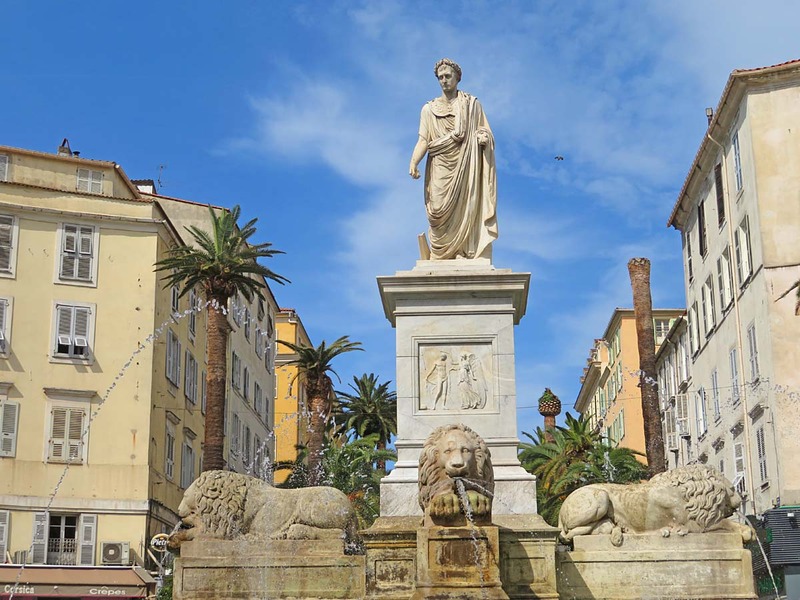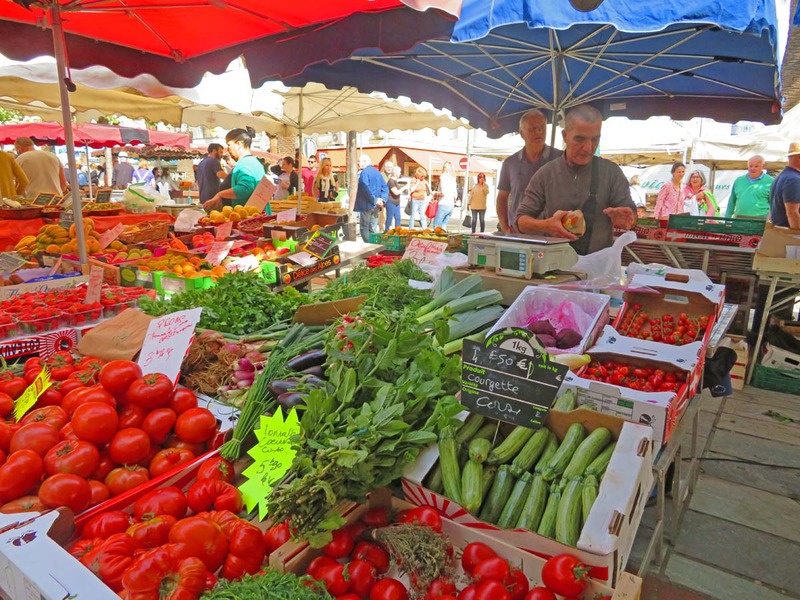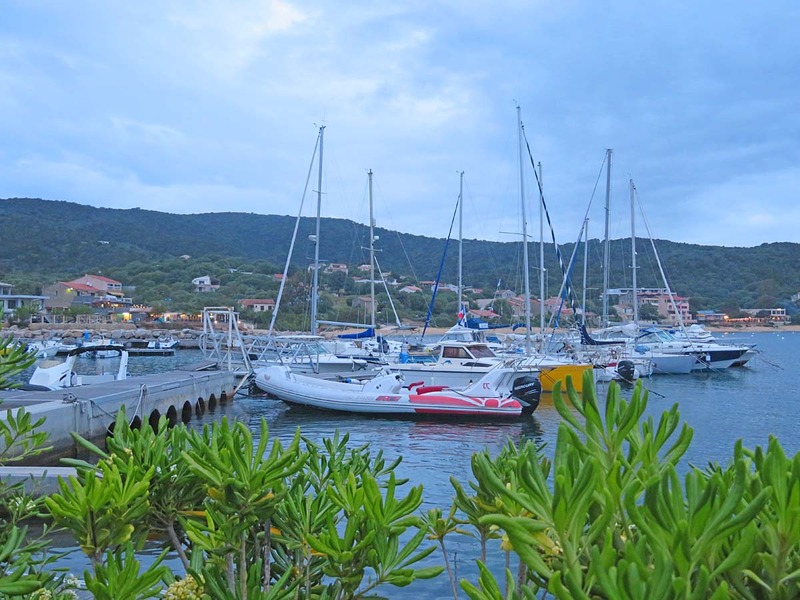Around Ajaccio
Sipping Champagne on a plane? Wow, but don’t get me wrong. This was not to mark my first visit to the island, but a treat for all passengers to celebrate the Air Corsica inaugural flight from London to Ajaccio. So now, less than two hours from Stansted, you can land on this highly distinctive French island, beautifully coloured by a long Italian past and a unique Corsican culture with its own language and traditions.
 The airport, ‘Napoléon Bonaparte’, prepares you straightaway for all things royal from the Imperial Chapel, resting place of family members and descendants, the latest in 1997, to statues, street names and the ancestral home of the Bonaparte family where Napoléon was born in 1769. Restored and furnished in style, it is the most popular attraction in the capital, followed by the Fesch Museum which displays one of the top collections of Italian paintings. This was acquired by Cardinal Fesch who received the title and ensuing wealth from his uncle, Napoléon.
The airport, ‘Napoléon Bonaparte’, prepares you straightaway for all things royal from the Imperial Chapel, resting place of family members and descendants, the latest in 1997, to statues, street names and the ancestral home of the Bonaparte family where Napoléon was born in 1769. Restored and furnished in style, it is the most popular attraction in the capital, followed by the Fesch Museum which displays one of the top collections of Italian paintings. This was acquired by Cardinal Fesch who received the title and ensuing wealth from his uncle, Napoléon.
But on this magnificent bay framed by mountains, Ajaccio has much to offer alongside history. The old town is a delightful maze of colourful lanes where elegant Italian façades mingle with traditional ‘village’ shops, glinting jewellery boutiques tempting you with red coral or unusual mountain stones and fragrant outlets for natural beauty products, their most highly prized ingredient the anti-ageing ‘immortelle’.  Then there is the Sunday market full of local produce, giant lemons, oranges, honey, cheese, Corsican ham, chestnut flour cake and so much more. Across the road and away from ferries and cruise ships, fishing boats bob in the old harbour just below the citadel. Walk up to the jetty and you will enjoy one of the best city views.
Then there is the Sunday market full of local produce, giant lemons, oranges, honey, cheese, Corsican ham, chestnut flour cake and so much more. Across the road and away from ferries and cruise ships, fishing boats bob in the old harbour just below the citadel. Walk up to the jetty and you will enjoy one of the best city views.
Then of course Ajaccio has sandy beaches, just a few of 200 or so dotted along the island’s 1000 km coast, plus a lively palm-lined promenade and alfresco restaurants serving seafood, in a delicious blend of French and Italian cuisine with a Corsican touch. But before settling down to dinner, we walked to the end of the peninsula looking out to the ‘sanguinaires’ or blood-red islands. Wild flowers splashed colour on verdant slopes, the old Genoese tower glowed on the hilltop, then the sun set over the sea in stunning shades of red and gold. Truly romantic.
 Ajaccio claims around 60,000 people, though spread along the meandering shore it rarely feels like it, but if you prefer to get away from it all, for a day or more, you could head south to Porto Pollo, about an hour away. A city folks’ favourite escape, the resort feels like a village nestling around a quiet harbour and a beach lapped by crystal clear water, while red-roofed houses and their pretty gardens clamber up the slopes. In the lovely Hotel Le Golfe, Antoine can arrange a trip along the coast in a ‘rescued’ lifeboat with breakfast or picnic on board.
Ajaccio claims around 60,000 people, though spread along the meandering shore it rarely feels like it, but if you prefer to get away from it all, for a day or more, you could head south to Porto Pollo, about an hour away. A city folks’ favourite escape, the resort feels like a village nestling around a quiet harbour and a beach lapped by crystal clear water, while red-roofed houses and their pretty gardens clamber up the slopes. In the lovely Hotel Le Golfe, Antoine can arrange a trip along the coast in a ‘rescued’ lifeboat with breakfast or picnic on board.
A few minutes drive from the village is a marshland for protected birds and among reeds and yellow irises, you’ll find a boardwalk and hides and if you’re lucky, you might spot some rare species of herons. Further on, you reach the fertile Taravo plain where cattle graze in lush grass and then you arrive in Filitosa, one of the best archaeological sites in Corsica.
 Spanning around 8,000 years from late Neolithic to Roman times, it spreads across open ground, totally wild and natural, with dramatic rocks, trails and steps leading to menhirs carved with human faces and circular structures which may have been temples built by the Torrean people. It’s hauntingly beautiful, carpeted in flowers including Illyrian lilies, growing virgin white in a meadow. Meanwhile, the Mediterranean scrub of the maquis releases its scent across the hills, thyme, rosemary, fennel, myrtle, juniper, rock rose, to name just a few.
Spanning around 8,000 years from late Neolithic to Roman times, it spreads across open ground, totally wild and natural, with dramatic rocks, trails and steps leading to menhirs carved with human faces and circular structures which may have been temples built by the Torrean people. It’s hauntingly beautiful, carpeted in flowers including Illyrian lilies, growing virgin white in a meadow. Meanwhile, the Mediterranean scrub of the maquis releases its scent across the hills, thyme, rosemary, fennel, myrtle, juniper, rock rose, to name just a few.
But for true wilderness, you should venture into the hinterland draped in remote villages and valleys, mountains and rocky crests. Short of time? No problem, plan a day trip from Ajaccio to hill top Sartène, one of the most authentic of all Corsican villages. It’s a scenic drive, first through vineyards and olive groves then climbing to over 300 metres to a medieval gem of granite houses and cobbled lanes huddled around a church and shaded square. Locals watch the world go by, visitors pop into the Musée de la Préhistoire and restaurants serve mountain food often flavoured with chestnuts, wild boar, lamb, veal, charcuterie, ewe’s cheese and more.  The views up there take your breath away, from the Rizzanese valley to the mountains which cover two thirds of this amazing island. Mountains and sea, Corsica has it all.
The views up there take your breath away, from the Rizzanese valley to the mountains which cover two thirds of this amazing island. Mountains and sea, Corsica has it all.
More information
As well as Ajaccio, Air Corsica launched direct flights to Bastia and Figari.
www.lesgrandesmaisonscorses.com
Public transport is limited but if you don’t mind winding roads, you can hire a car through Air Corsica Fly and Drive, in partnership with Hertz. Alternatively, most hotels can arrange local trips and activities.











